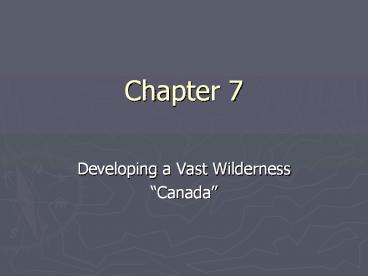Developing a Vast Wilderness - PowerPoint PPT Presentation
1 / 27
Title:
Developing a Vast Wilderness
Description:
Chapter 7 Developing a Vast Wilderness Canada Section 1 The Vikings came to North America around 1000 A.D. Nearly 5 centuries later (500 years) an Italian ... – PowerPoint PPT presentation
Number of Views:92
Avg rating:3.0/5.0
Title: Developing a Vast Wilderness
1
Chapter 7
- Developing a Vast Wilderness
- Canada
2
Section 1
- The Vikings came to North America around 1000
A.D. - Nearly 5 centuries later (500 years) an Italian
navigator, Giovanni Caboto, explored the North
American landed in Newfoundland and claimed it
for England. - England and France were the first two nations
that tried to colonize Canada.
3
(No Transcript)
4
Distinction of Canada
- Roman Catholic- French
- Protestant- English
- The British government split Canada into 2
provinces. - Upper Canada (Ontario)- Spoke English
- Lower Canada (Quebec)- Spoke French
- Ruperts land, which was owned by a British
fur-trading company, separated the two.
5
(No Transcript)
6
(No Transcript)
7
Continental Expansion
- Roads, canals and railroads were developed to
make the land of Canada more accessible to
pioneers. - 1885 a railway was completed from Montreal to
Vancouver. - Around that time gold, copper, zinc and silver
deposits were discovered in the Yukon Territory.
8
(No Transcript)
9
Population Growth
- As the population grew Canada became more urban
and industrial. - Most of the growth took place within 100 miles of
the U.S. border. - Canada became an economic power in the 20th
century.
10
Canadian Government
- In 1931 Canada was independent of Britain.
- Parliamentary Government- System where
legislative and executive functions are combined
in a legislature called parliament. - Parliament- representative lawmaking body whose
members are elected or appointed and in which
legislative and executive functions are combined. - Symbolic head of state is still the British
monarch.
11
Chapter 7 Section 2
- Economy and Culture of Canada
12
Economy of Canada
- Canada is one of the richest countries in the
world. - Industries of Canada- Farming, logging, mining
and fishing. - The majority of Canadas manufacturing companies
are in southern Quebec and Ontario. - Nearly 15 of Canadians earn their living from
manufacturing. (Automobiles, steel, household
appliances and electronics).
13
(No Transcript)
14
Service Industries
- This is Canadas economic backbone. These
industries provide more jobs for Canadians than
all other industries combined. - Examples of industries include finance,
utilities, trade, transportation, tourism,
communications, insurance and real estate.
15
Cultures of Canada
- People that settled Canada- Inuit, First Nations,
French, English and other Europeans. - French and English are the official languages.
- Christianity is the dominant religion.
(Protestant and Catholic)
16
Settling Canada
- Harsh climate and transportation routes have
affected the settlement patterns of Canada. - 80 of all Canadians live on just 10 of the
land. - Most live in urban areas along the southern
portion of the country.
17
Canadian Life
- Workforce 55 men 45 women
- 97 literacy rate in the country
- Ice hockey, rodeo, fishing, hunting, skiing, golf
and football are some of the favorite activities.
18
Section 3
- Location, climate, different people, settling
area and local industries all account for the
variety of lifestyles within a sub-region. - Most large cities in the Quebec and Ontario are
near the Great Lakes and the St. Lawrence River.
19
Provinces of Canada
- Atlantic Province- Prince Edward Island, New
Brunswick, Nova Scotia and Newfoundland.
(Logging, fishing and mining). - Prairie Provinces- Breadbasket Manitoba,
Saskatchewan and Alberta. (Agriculture, minerals,
oil, coal and natural gas).
20
Provinces Cont.
- Core Provinces-Heartland Quebec and Ontario. 3
out of 5 Canadians live here. (Agriculture,
mining and hydroelectric power). - Pacific Provinces and Territories- British
Columbia, Yukon Territory, Northwest Territory
and the Nunavut. (Logging, fishing mining, and
hydroelectric-power).
21
Nova Scotia
22
Alberta
23
Quebec
24
Ontario
25
British Columbia
26
Most Populated Cities
- Toronto, Ontario- 5,113,419
- Montreal, Quebec- 3,635,571
- Vancouver, B.C.- 2,116,581
- Ottawa, Ontario- 1,130,761
- Calgary, Alberta1,079,130
27
Famous Canadians
- Avril Lavigne Pam Anderson
- Shania Twain Alanis Morissette
- Bryan Adams Jim Carrey
- Howie Mandel

